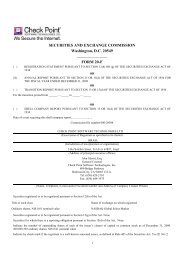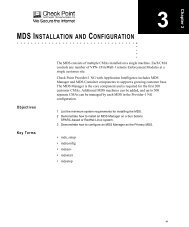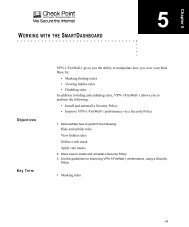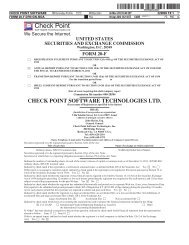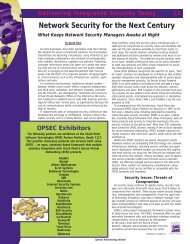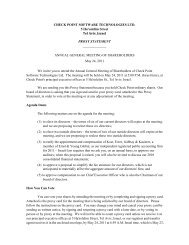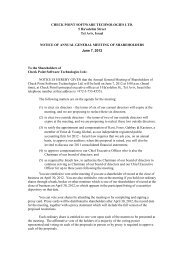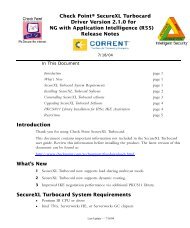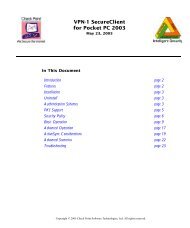Create successful ePaper yourself
Turn your PDF publications into a flip-book with our unique Google optimized e-Paper software.
In the Virtual IP address for DHCP server replies, specify an IP address from the sub<br />
network of the IP addresses which are designated for Office Mode usage (e.g.<br />
10.130.56.254). Since Office Mode supports DHCP Relay method for IP<br />
assignment, you can direct the DHCP server as to where to send its replies. The<br />
routing on the DHCP server and that of internal routers must be adjusted so that<br />
packets from the DHCP server to this address are routed through the gateway.<br />
Under Multiple Interfaces, specify whether you want routing to be done after the<br />
encapsulation of Office Mode packets, to allow traffic to be routed correctly when<br />
your gateway has multiple external interfaces.<br />
If you wish to use the Anti-Spoofing feature, continue to step 5, otherwise skip to<br />
step 7.<br />
5 Create a network object to represent the address space you’ve allocated for Office Mode<br />
on your DHCP server, by selecting Manage >Network Objects >New > Network.<br />
In the Network Properties — General tab, set the DHCP address range as follows:<br />
In Network Address specify the first address that is used (e.g. 10.130.56.0).<br />
In Net Mask enter the subnet mask according to the amount of addresses that is used<br />
(entering 255.255.255.0, for example, designates that all 254 IP addresses from<br />
10.130.56.1 until 10.130.56.254 are set aside for SecureClient Office Mode addresses<br />
on the DHCP server).<br />
Changes to the Broadcast Address section and the Network Properties — NAT tab are<br />
not necessary.<br />
Close the network object properties window.<br />
6 Return to the Gateway object, open the Remote Access > Office Mode page. In the<br />
Additional IP addresses for Anti-Spoofing, select the network object you have created<br />
with the IP address range you have set aside for Office Mode on the DHCP server.<br />
7 Install the policy.<br />
8 Make sure that all the internal routers are configured to route all the traffic destined to<br />
the internal address space you had reserved to Office Mode users through the VPN-1<br />
Pro Gateway. For instance, in the example above it is required to add routes to the class<br />
C sub network of 10.130.56.0 through the gateway’s IP address.<br />
Note - Office mode is supported only in Connect Mode.<br />
Configuring the Gateway for Visitor Mode<br />
To enable the Visitor mode on the Gateway:<br />
On the Gateway object running the Visitor Mode Server, Remote Access page > Visitor<br />
Mode section, select Support Visitor Mode.<br />
SecuRemote/SecureClient. 8



